Collection of materials relating to neuro-ophthalmology as part of the Neuro-Ophthalmology Virtual Education Library.
NOVEL: https://novel.utah.edu/
TO
Filters: Collection: "ehsl_novel_novel"
1 - 25 of 20
| Title | Creator | Description | Subject | ||
|---|---|---|---|---|---|
| 1 |
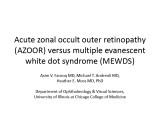 |
Acute Zonal Occult Outer Retinopathy (AZOOR) versus Multiple Evanescent White Dot Syndrome (MEWDS) | Asim V. Farooq, MD; Michael T. Andreoli, MD; Heather E. Moss, MD | PPT case report on acute zonal occult outer retinopathy (AZOOR) versus multiple evanescent white dot syndrome (MEWDS). | AZOOR; MEWDS; Paracentral Scotoma; Goldmann Visual Field; Photoreceptor Loss |
| 2 |
 |
Bitemporal Hemianopia | Julia Mathew Padiyedathu, MD; Rudrani Banik, MD | Power point of case presentation of patient with painless progressive vision loss, optic nerve cupping with pallor and history of significant alcohol and tobacco use. Patient initially diagnosed at outside institution with normal tension glaucoma and toxic optic neuropathy. Exam suggests bitempora... | Ditemporal Visual Field Defect; Toxic Optic Neuropathy; Pituitary Adenoma; Compressive Optic Neuropathy |
| 3 |
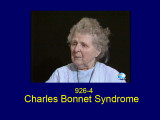 |
Charles Bonnet Syndrome | Shirley H. Wray, MD, PhD, FRCP | The patient is a 79 year old woman with a chief complaint of visual hallucinations. She carries a diagnosis of glaucoma and cataracts. The patient was in good health until two weeks prior to admission when she noted a black cloud in her visual field in the top central area. The cloud gradually chang... | Occipital Lobe; Visual Hallucinations; Release Hallucinations; Charles Bonnet Syndrome |
| 4 |
 |
Clinical Visual Electrophysiology | Gregory P. Van Stavern, MD; Byron Lam, MD | A description of the use of electrophysiology to examine the visual system. | Electrophysiology; Visual Exam |
| 5 |
 |
Confrontation Visual Fields - A Concise Guide for Ophthalmology and Neurology Trainees | Stephen C. Pollock, MD | The guide describes the techniques required to competently perform confrontation visual fields. It outlines a basic screening protocol and discusses methods for further defining defects identified during the screening process. A mini-atlas of visual field defects is included as an appendix. | Confrontation Visual Fields; Visual Field Testing; Perimetry; Visual Field Loss; Visual Field Defect; Ocular Examination; Visual Sensory Evaluation; Neurologic Examination |
| 6 |
 |
Disability Evaluation Under Social Security | John Pula, MD | A. How do we evaluate visual disorders? 1. What are visual disorders? Visual disorders are abnormalities of the eye, the optic nerve, the optic tracts, or the brain that may cause a loss of visual acuity or visual fields. A loss of visual acuity limits your ability to distinguish detail, read, or do... | Visual Impairment; Visual Disorders; Legal Blindness |
| 7 |
 |
Illustrations of the Afferent Visual Pathway and Concepts Surrounding Trans-Synaptic Neuroaxonal Degeneration in the Visual Pathway in Multiple Sclerosis | Olwen C. Murphy; Peter A. Calabresi; Shiv Saidha | Image 1 title: Functionally-eloquent organization of the afferent visual pathway; Image 1 description: The afferent visual pathway is a sensory pathway comprised of 3 neurons. The 1st order neurons are the shortest neurons in the pathway and are entirely unmyelinated. The cell bodies of the 1st orde... | Optic Neuritis; Multiple Sclerosis; Neuroaxonal Degeneration; Trans-synaptic Degeneration; Visual Pathway; Functional Eloquence |
| 8 |
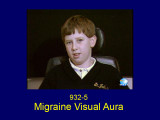 |
Migraine Visual Aura | Shirley H. Wray, MD, PhD, FRCP | The patient is a 9 year old right handed boy who developed headaches in 1993 at the age of 8. At that time he told his mother that he had bad headaches starting at the back of the head, usually bioccipital, spreading over the top of the head to his forehead. The headaches were short in duration last... | Migraine Visual Aura without Headache; Metamorphopsia; Macropsia - Hemi-macropsia; Alice in Wonderland Syndrome; Occipital Lobe; Visual Phenomena |
| 9 |
 |
Non-Organic Visual Loss | Omar Ozgur, MD; Rudrani Banik, MD | Power point of case presentation of 12 year old girl with recurrent monocular visual loss. Examination is normal. Differential diagnosis discussed, including non-organic visual loss. Diagnostic testing for non-organic visual loss reviewed. Slide 4: Figure 1: Table of exam findings Slide 5: Figure 2... | Non-organic Visual Loss; Monocular Visual Loss |
| 10 |
 |
OKN Testing for Non-physiologic Visual Loss | Walsh and Hoyt Clinical Neuro-Ophthalmology, 6th Edition | Description of OKN testing for non-physiologic visual loss. | OKN Testing; Non-physiologic Visual Loss |
| 11 |
 |
Optochiasmal Tuberculoma | Jeanie Paik, MD; Rudrani Banik, MD | PowerPoint of case of chiasmal tuberculoma causing bitemporal defect in patient with tuberculosis on RIPE treatment; case history, differential diagnosis and treatment discussed. | Chiasmal Disorder; Chiasmal Tuberculoma; Bitemporal Visual Field Defect; Ethambutol Optic Neuropathy |
| 12 |
 |
Patient Portal: Transient Vision Loss | Anthony Brune, DO | Transient visual loss is the term used to describe loss of part or all of the vision in one or both eyes temporarily. Some people do not experience a complete loss of the affected vision and instead describe the abnormality as "blurring" or like "looking through a veil." The vision typically returns... | Transient visual loss |
| 13 |
 |
Proprioception Testing for Non-physiologic Visual Loss | Walsh and Hoyt Clinical Neuro-Ophthalmology, 6th Edition | Description of proprioception for non-physiologic visual loss. | Proprioception Testing; Non-physiologic Visual Loss |
| 14 |
 |
Stereo Acuity Testing for Non-physiologic Visual Loss | Walsh and Hoyt Clinical Neuro-Ophthalmology, 6th Edition; Omar Ozgur, MD; Rudrani Banik, MD; François-Xavier Borruat | Description of stereo acuity for non-physiologic visual loss. | Stereo Acuity Testing; Non-physiologic Visual Loss |
| 15 |
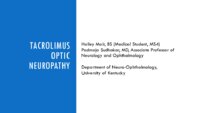 |
Tacrolimus Optic Neuropathy | Hailey Mair, BS; Padmaja Sudhakar, MD | This PowerPoint slide deck will describe tacrolimus optic neuropathy which is a very rare form of optic neuropathy but remains a potential issue in many patients that receive this drug. | Optic Neuropathy; Tacrolimus; Tacrolimus Associated Visual Loss |
| 16 |
 |
The Clinical Examination of Higher Order Visual Function: Syndrome-Based Approach | Victoria S. Pelak, MD; James R. Bateman, MD, MPH; Brianne Bettcher, PhD | Explanation of higher order visual function examination. See accompanying video, Double simultaneous visual field stimulation: https://collections.lib.utah.edu/ark:/87278/s6gn2h9d | Visual Function |
| 17 |
 |
The Clinical Examination of Higher Order Visual Function: Syndrome-based Approach - Visual Neglect | Victoria S. Pelak, MD; James R. Bateman, MD, MPH; Brianne Bettcher, PhD | Explanation of higher order visual function examination. See accompanying video, Double simultaneous visual field stimulation: https://collections.lib.utah.edu/ark:/87278/s6gn2h9d | Visual Function; Visual Neglect |
| 18 |
 |
Transient Monocular Blindness (Guest Lecture) | Shirley H. Wray, MD, PhD, FRCP | See also: http://content.lib.utah.edu/cdm/ref/collection/ehsl-shw/id/293 and http://content.lib.utah.edu/cdm/ref/collection/ehsl-shw/id/96 | Retinal Emboli; Transient Monocular Blindness; Ocular Stroke; Transient; Transient Visual Loss; Sunlight Provoked Transient Monocular Blindness; Low Pressure Retinopathy; Ipsilateral Internal and External Carotid Occlusive Disease; Ischemic Eye Syndrome; Retinal Stroke; Ocular Ischemic Sy... |
| 19 |
 |
Transient Visual Loss (Portuguese) | NANOS | About transient visual loss. | Transient Visual Loss; Patient Brochure |
| 20 |
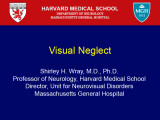 |
Visual Neglect | Shirley H. Wray, MD, PhD, FRCP | The patient following infarction of the non-dominant right parietal lobe has visual hemi-neglect on the left. Review: (ref 2) Patient's with hemi-neglect ignore or fail to attend to stimuli on the side of space contralateral to their lesion. Neglect can be multimodal in that all stimuli whether audi... | Impaired Initiation of Horizontal Saccades to the Left; Deviation of the Eyes to the Left Under Closed Eyelids; Normal Pursuit Eye Movements; Parietal Lobe Infarct; Visual Neglect |
1 - 25 of 20
